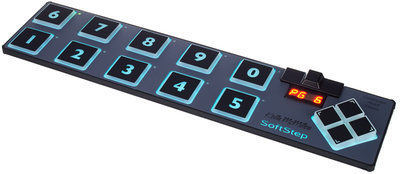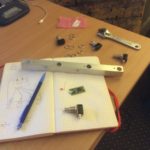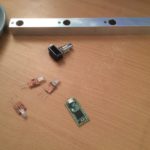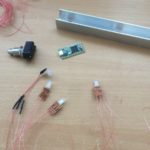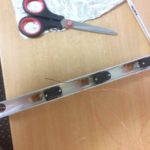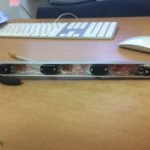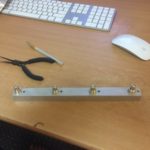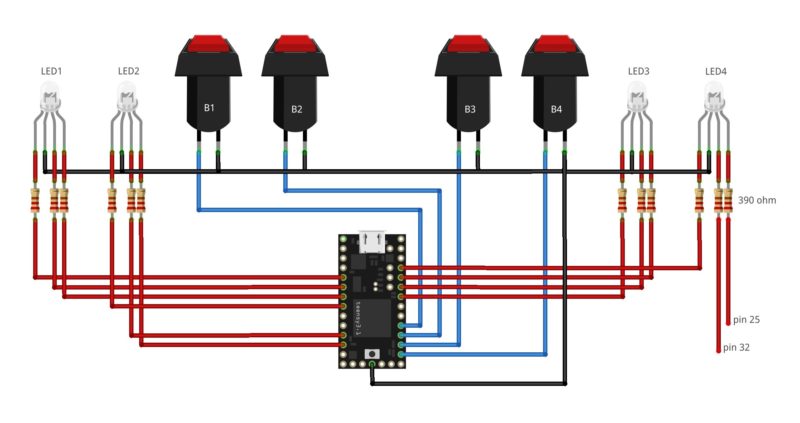Friends. Objects. Lights. Feet.
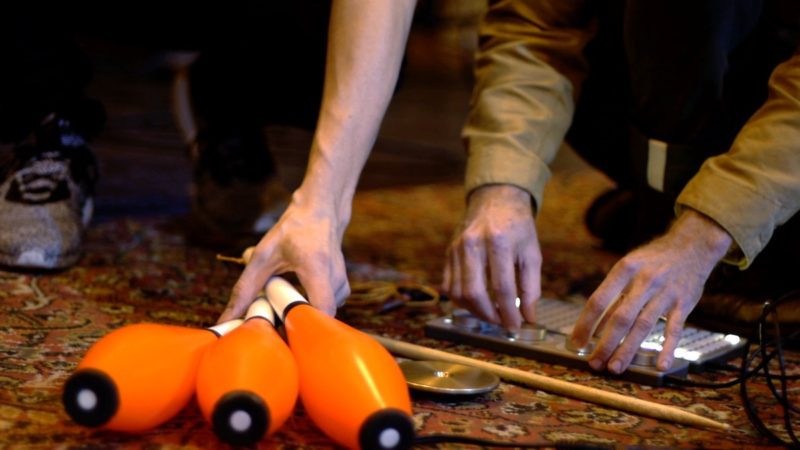
Over the years I have had many wonderful discussions with people whom I have never met. Either through emails, forums, or even chatrooms I have talked about all manner of things with people scattered around the world. Sometimes these virtual friendships manifest in the physical world and a thing is born. An art thing. This is one of those times.
I first came across Brian Crabtree (tehn) through the monome controllers he, along with Kelli Cain, designed. From the first video I came across about ten years ago I found the simultaneously minimal and alien, device fascinating. The full ramifications of what that kind of controller did, and the eventual impact it would have on controller design in general, was unknown to me at the time. It was just a beautiful thing that was used to make electronic music.
Years later, when I started programming my own musical tools/instruments, I looked up the monome controllers again. Since I was writing software to perform with, I needed a controller and knew I didn’t want a generic fader/knob-bank style one. My thinking was that the monome interface was close enough to a piano keyboard that I would be able to recycle the physical dexterity/virtuosity that I had built up through years of playing, but at the same time different enough that I wouldn’t bring along any of the baggage associated with that having learned all that technique, something I talk about in more detail in the first chapter of my PhD thesis.
I began posting on the monome forum (the original version of which is now retired and replaced by the platform-agnostic and wonderfully diverse lines forum), initially asking questions about the various apps that existed, and how people approached performing with and programming for the monome. There’s something about message boards, and online communities in general, that I find interesting/captivating. Perhaps it’s the (relatively) equal footing where everyone is just a(n) handle/avatar, or maybe it’s the multitude of simultaneous and occasionally overlapping conversations, but forums represent what “the internet” looks like to me. I guess it also helps that I (digitally) ‘grew up’ on them.
On the monome/lines forum, much like in any community (online or otherwise), you start crossing paths with some of the same people in different threads. On these forums I first encountered the work of Jay Gilligan.
///////////////////////////////////////////////////////////////////////////////////////////////////////////////////////////////////////////////////////////////////////
Jay is a juggler. That is, he often manipulates objects. Beyond that, what juggling is is actually difficult to pin down, especially in a contemporary context. (Watch Jay’s TEDx talk, or read his book of essays on contemporary juggling if you would like to know more.) He also makes music, and collaborates with other musicians. I had seen some videos he had made with Brian and enjoyed the unusual combinations of things. Juggling, for whatever reason, wasn’t something I thought about very much, much less in an improv/performance context, so it was refreshing to see such a creative application of it.
I had first spoken to Jay via Skype last year when I approached him about creating an analysis of his juggling for my improv analysis project. I was excited to see/read the kinds of things that he would be concerned with while performing, and given the nature of juggling worked (being so physical), it also helped to push the boundaries of of the improv analysis system itself. During that conversation, and subsequent reading through of his analysis, I was struck by how much overlap there was with not only the concerns, but terminology of musical improvisation. Terms like rhythm, theme, and feel are peppered throughout his analysis, and the relationship between pre-composed routines and in-the-moment improvisation is at the forefront of his thinking.
There is something about the objective reality of juggling that I find intriguing. Physics is, generally speaking, unyielding when it comes to objects in space. If you throw a ball or club in to the air, your relationship with that object is not yet finished (even if you decide to let the object fall). You are not only manipulating objects, but their trajectories in space and time. It is a complex and multidimensional engagement with the fluidity and fragility of reality.
(Tangentially, I find comedy/theatre improv interesting [and have written about this a couple of times] for similar reasons. The objective reality of language and narrative creates a grounding plane that the intrinsically abstract nature of sound and music does not. Playing with, and against, this layer of base reality is something that high level comedy improvisers engage with.)
During our performance together I couldn’t help but just watch Jay. It was a pleasure to perform with someone who had such a complex and detailed understanding of movement. In watching the videos back I can see in his performances what I can hear when I listen to brilliant (musical) improvisers.
///////////////////////////////////////////////////////////////////////////////////////////////////////////////////////////////////////////////////////////////////////
Going into the performance I knew I wanted to work with lights, something I have done in many performances and contexts in the past. But this time I wanted to approach it differently, in that I wanted to use four regular light bulbs, specifically incandescent light bulbs, controlled with a DMX dimmer.
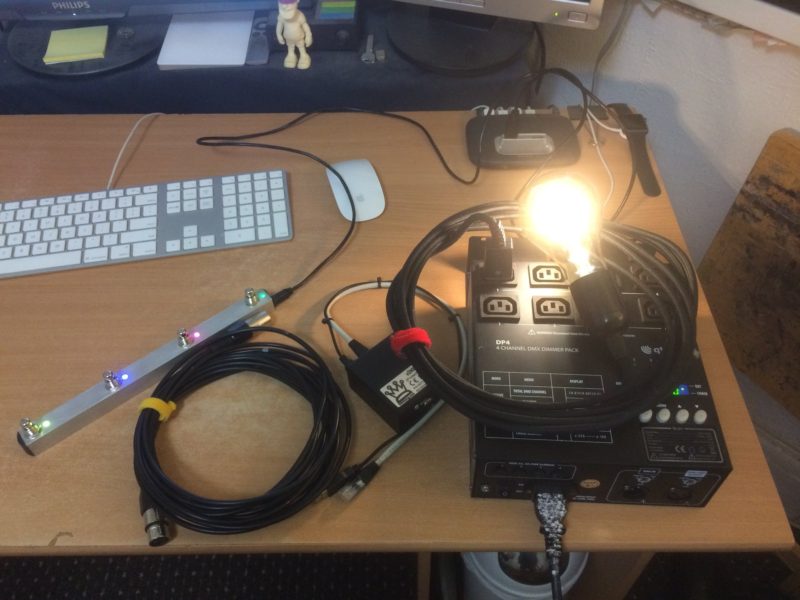
Using individual light bulbs in this way would allow me to further explore the idea of localized dynamic lights, similar to Everything. Everything at once. Once. (2) and Everything. Everything at once. Once. (3). Whereas the lights (halogen work lamps) in those videos are physically controlled by human beings, the individual bulbs would be computer controlled. This, coupled with the fact that there are twice as many light sources (4 vs 2) allows for things that would not be possible otherwise.
This idea/approach is somewhat inspired a video I had seen some years who, which highlighted the drastic difference lighting can have on a face. Through synchronized changes in brightness coming from multiple light sources you can create the illusion of moving shadows, even though the light sources themselves do not move. This is particularly effective when done on a human face, as the subtle changes in expression are amplified and de/re-contextualized based on the shifting shadows(/lights).
Here is a similar pattern (offset sine wave) shown on just the bulbs:
Putting the bulbs on the floor creates a beautiful pattern of rhythmic shadows behind the objects the lights are shining on. Since there are only four bulbs you don’t get the smooth illusion of a moving shadow like in the face example above (or like in the end of this Martin Messier video), but I find the rhythmic aspect of the lighting engaging. The resolution of movement of shadows is something I will play with further in the future, especially when coupled with multiple camera sources like I talk about towards the bottom of this blog post.
Here are some rhythmic shadows behind Angie:
The fact that these bulbs are incandescent (as opposed to the LED lights found in most DMX par lamps) is important in that you get significantly more (perceptual) resolution towards the dimmer settings on the lights. Even though there are still only 255 steps of brightness, the fact that the filaments in the bulb takes time to heat/cool adds a slew to the changes in brightness. DMX lights are notoriously shitty when it comes to these kinds of changes in brightness, where you can see each step of brightness jump up. An apt metaphor here would be the difference between analog and digital signals, where you have smooth/continuous changes in brightness vs discrete/stepped changes (this difference is only perceptual due to the incandescent nature of the bulbs as the control signals are digital in both cases).
Here you can see a good example of the smoothness at dimmer settings (the staging of this is something I want to play with in an upcoming Everything. Everything once. Once. video):
///////////////////////////////////////////////////////////////////////////////////////////////////////////////////////////////////////////////////////////////////////
My go-to foot switch for live performance has been the KMI SoftStep. It is sturdy, compact, has decoupled LED feedback, and is easy to program for (especially when using a set of abstractions for Max by Jeff Kaiser). The one downside to the SoftStep is that, because of the nature of its smart fabric sensors, the pedals on the SoftStep feel mushy. This doesn’t matter when you are casually changing presets or scenes in a performance, but when you want something to happen now, it matters.
Since I knew there were some situations where I wanted/needed tighter, timing-critical control, I set about designing and building a foot switch that would work well in those circumstances. I based the overall look and size on an early experiment with DIY foot switches (and my first Arduino project!) since the aluminum channel I had was the perfect width for the switches I had in mind.
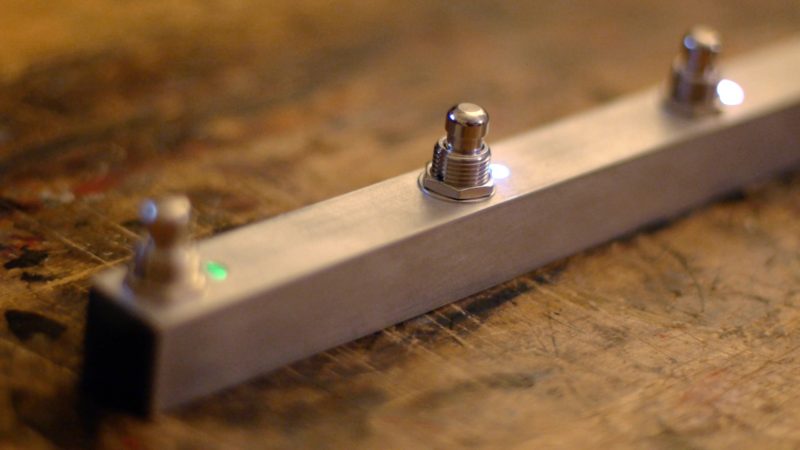
In terms of feel, the best solution I’ve come across in a DIY context was from metal momentary SPST switches similar to these. The feel is very similar to the Line 6 DL-4 switches which I enjoyed for so many years. The amount of throw/movement feels good under the foot, and is consistent/predictable, and unlike the BOSS-style hinged foot switch mechanism, the bottom of the press feels solid.
Since I was going DIY with it, using an Arduino Teensy, and had PWM outputs to spare, I decided to use RGB LEDs instead of just red LEDs like in my previous build. This would allow me to do some slick interface things using color as mode or effect signifiers (as can be seen in the video below).
Here are some photos of the build in progress:
- sketch and components
- drilled with components
- wiring LEDs
- mounting in enclosure
- stuffed guts
- finished foot switch
Here is the wiring diagram for the hardware:
For the code side of things, I knew I wanted to use USB-MIDI, so the foot switch could work anywhere, and not require a serial connection, something I had done in projects in the past. Something I hadn’t done, however, was LED feedback in a USB-MIDI Arduino project. For help with that I turned a friend (Constantin Popp) who makes a bunch of Teensy-based controllers. He not only helped with the LED feedback, but with some general code structuring and improvements, which was welcome, since my Arduino/Processing programming isn’t super clean.
void loop() {
// button update
button1.update();
// send CC messages on button on
if (button1.fallingEdge()) {
usbMIDI.sendControlChange(1, 127, channel);
}
// send CC messages on button off
if (button1.risingEdge()) {
usbMIDI.sendControlChange(1, 0, channel);
}
// update MIDI
usbMIDI.read();
}
(click here to download the complete Arduino code)
Here is a video of the foot switch in action: (you can see some of the cool interface things that decoupled RGB LED feedback affords, and you can hear some of the analyzed skipping CD code I’ve been working on)
///////////////////////////////////////////////////////////////////////////////////////////////////////////////////////////////////////////////////////////////////////
So all four of these disparate things [Friends. Objects. Lights. Feet.] came together to make an art thing. An art thing that extends beyond the opening and closing of the venue doors one evening, or the start and end times of the videos below. It is a set of trajectories. It is complex. It is fluid. It is fragile.
Here are all the performance videos that Angela Guyton filmed that evening:
- Constanzo/Crabtree/Gilligan – Glowing Balls (1/7)
- Constanzo/Crabtree/Gilligan – White Rings (2/7)
- Constanzo/Crabtree/Gilligan – Balls and Clubs (3/7)
- Constanzo/Crabtree/Gilligan – Balls with String (4/7)
- Constanzo/Crabtree/Gilligan – Yarn (5/7)
- Constanzo/Crabtree/Gilligan – Orange Rings (6/7)
- Constanzo/Crabtree/Gilligan – Balloon and Bulbs (7/7)



